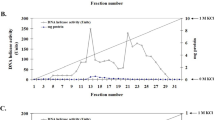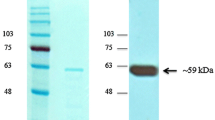Abstract
Human malaria is a major parasitic infection, and the situation has worsened mainly due to the emergence of resistant malaria parasites to several anti-malarial drugs. Thus, an urgent need to find suitable drug targets has led to the development of newer classes of anti-malarial drugs. Helicases have been targeted to develop therapeutics for viral, bacterial, and other microorganism infections. Recently, Plasmodium falciparum RuvB ATPases/helicases have been characterized and proposed as a suitable antimalarial drug target. In the present study, the screening of various compounds was done and the results suggest that PfRuvB1 ATPase activity is inhibited considerably by the novobiocin and partially by cisplatin and ciprofloxacin. Helicase assay of PfRuvB1 in the presence of various compounds suggest novobiocin, actinomycin, and ethidium bromide as potent inhibitors. Novobiocin inhibits the helicase activity of PfRuvB1 possibly by blocking the ATPase activity of PfRuvB1. This study is unique in respect to the identification of novobiocin as inhibitor of PfRuvB1, partially by competing with ATP binding at its active site and provides evidence for PfRuvB1 as target of novobiocin after DNA gyrase-B and HSP90. These studies will certainly help the pharmacologist to design and develop some novel inhibitor specific to PfRuvB1, which may serve as suitable chemotherapeutics to target malaria.




Similar content being viewed by others
References
Aggarwal M, Banerjee T, Sommers JA, Brosh RM Jr (2013) Targeting an Achilles’ heel of cancer with a WRN helicase inhibitor. Cell Cycle 12:3329–3335
Ahmad M, Ansari A, Tarique M, Satsangi AT, Tuteja R (2012a) Plasmodium falciparum UvrD helicase translocates in 3′ to 5′ direction, colocalizes with MLH and modulates its activity through physical interaction. PLoS One 7:e49385
Ahmad M, Singh S, Afrin F, Tuteja R (2012b) Novel RuvB nuclear ATPase is specific to intraerythrocytic mitosis during schizogony of Plasmodium falciparum. Mol Biochem Parasitol 185:58–65
Ahmad M, Tuteja R (2013a) Plasmodium falciparum RuvB1 is an active DNA helicase and translocates in the 5′-3′ direction. Gene 515:99–109
Ahmad M, Tuteja R (2013b) Plasmodium falciparum RuvB2 translocates in 5′-3′ direction, relocalizes during schizont stage and its enzymatic activities are up regulated by RuvB3 of the same complex. Biochim Biophys Acta 1834:2795–2811
Alt S, Mitchenall LA, Maxwell A, Heide L (2011) Inhibition of DNA gyrase and DNA topoisomerase IV of Staphylococcus aureus and Escherichia coli by aminocoumarin antibiotics. J Antimicrob Chemother 66:2061–2069
Augagneur Y, Jaubert L, Schiavoni M, Pachikara N, Garg A, Usmani-Brown S, Wesolowski D, Zeller S, Ghosal A, Cornillot E et al (2013) Identification and functional analysis of the primary pantothenate transporter, PfPAT, of the human malaria parasite Plasmodium falciparum. J Biol Chem 288:20558–20567
Bullard KM, DeLisle RK, Keenan SM (2013) Malarial kinases: novel targets for in silico approaches to drug discovery. Methods Mol Biol 993:205–229
Canduri F, Perez PC, Caceres RA, de Azevedo WF Jr (2007) Protein kinases as targets for antiparasitic chemotherapy drugs. Curr Drug Targets 8:389–398
Doerig C, Meijer L (2007) Antimalarial drug discovery: targeting protein kinases. Expert Opin Ther Targets 11:279–290
Donnelly A, Blagg BS (2008) Novobiocin and additional inhibitors of the Hsp90 C-terminal nucleotide-binding pocket. Curr Med Chem 15:2702–2717
Elkaim J, Castroviejo M, Bennani D, Taouji S, Allain N, Laguerre M, Rosenbaum J, Dessolin J, Lestienne P (2012) First identification of small-molecule inhibitors of pontin by combining virtual screening and enzymatic assay. Biochem J 443:549–559
Field HJ, Biswas S (2011) Antiviral drug resistance and helicase-primase inhibitors of herpes simplex virus. Drug Resist Updat 14:45–51
Flannery EL, Chatterjee AK, Winzeler EA (2013) Antimalarial drug discovery—approaches and progress towards new medicines. Nat Rev Microbiol 12:849–862
Flatman RH, Eustaquio A, Li SM, Heide L, Maxwell A (2006) Structure-activity relationships of aminocoumarin-type gyrase and topoisomerase IV inhibitors obtained by combinatorial biosynthesis. Antimicrob Agents Chemother 50:1136–1142
Frick DN (2003) Helicases as antiviral drug targets. Drug News Perspect 16:355–362
Goodman CD, Su V, McFadden GI (2007) The effects of anti-bacterials on the malaria parasite Plasmodium falciparum. Mol Biochem Parasitol 152:181–191
Grigoletto A, Neaud V, Allain-Courtois N, Lestienne P, Rosenbaum J (2013) The ATPase activity of reptin is required for its effects on tumor cell growth and viability in hepatocellular carcinoma. Mol Cancer Res 11:133–139
Gunaherath GM, Marron MT, Wijeratne EM, Whitesell L, Gunatilaka AA (2013) Synthesis and biological evaluation of novobiocin analogues as potential heat shock protein 90 inhibitors. Bioorg Med Chem 21:5118–5129
Heide L (2013) New aminocoumarin antibiotics as gyrase inhibitors. Int J Med Microbiol 304:31–36
Jackson AP, Maxwell A (1993) Identifying the catalytic residue of the ATPase reaction of DNA gyrase. Proc Natl Acad Sci U S A 90:11232–11236
Jirage D, Keenan SM, Waters NC (2010) Exploring novel targets for antimalarial drug discovery: plasmodial protein kinases. Infect Disord Drug Targets 10:134–146
Kwong AD, Rao BG, Jeang KT (2005) Viral and cellular RNA helicases as antiviral targets. Nat Rev Drug Discov 4:845–853
Li B, Pai R, Di M, Aiello D, Barnes MH, Butler MM, Tashjian TF, Peet NP, Bowlin TL, Moir DT (2012) Coumarin-based inhibitors of Bacillus anthracis and Staphylococcus aureus replicative DNA helicase: chemical optimization, biological evaluation, and antibacterial activities. J Med Chem 55:10896–10908
Maloney, P., Hedrick, M., Peddibhotla, S., Hershberger, P., Milewski, M., Gosalia, P., Li, L., Preuss, J., Sugarman, E., Hood, B., et al. (2011). A selective inhibitor of Plasmodium falciparum glucose-6-phosphate dehydrogenase (PfG6PDH). Probe Reports from the NIH (http://www.ncbi.nlm.nih.gov/entrez/queryfcgi?cmd=Retrieve&db=PubMed&dopt=Citation&list_uids=23762930)
Marcu MG, Chadli A, Bouhouche I, Catelli M, Neckers LM (2000) The heat shock protein 90 antagonist novobiocin interacts with a previously unrecognized ATP-binding domain in the carboxyl terminus of the chaperone. J Biol Chem 275:37181–37186
Mpangase PT, Szolkiewicz MJ, le Grange M, Smit JH, Burger PB, Joubert F (2013) Discovery-2: an interactive resource for the rational selection and comparison of putative drug target proteins in malaria. Malar J 12:116
Murray CJ, Rosenfeld LC, Lim SS, Andrews KG, Foreman KJ, Haring D, Fullman N, Naghavi M, Lozano R, Lopez AD (2012) Global malaria mortality between 1980 and 2010: a systematic analysis. Lancet 379:413–431
Raghu Ram EV, Kumar A, Biswas S, Kumar A, Chaubey S, Siddiqi MI, Habib S (2007) Nuclear gyrB encodes a functional subunit of the Plasmodium falciparum gyrase that is involved in apicoplast DNA replication. Mol Biochem Parasitol 154:30–39
Ramdhave AS, Patel D, Ramya I, Nandave M, Kharkar PS (2013) Targeting heat shock protein 90 for malaria. Mini Rev Med Chem 13:1903–1920
Rosenbaum J, Baek SH, Dutta A, Houry WA, Huber O, Hupp TR, and Matias PM (2013) The emergence of the conserved AAA + ATPases pontin and reptin on the signaling landscape. Sci Signal 6, mr1
Seow F, Sato S, Janssen CS, Riehle MO, Mukhopadhyay A, Phillips RS, Wilson RJ, Barrett MP (2005) The plastidic DNA replication enzyme complex of Plasmodium falciparum. Mol Biochem Parasitol 141:145–153
Shadrick WR, Ndjomou J, Kolli R, Mukherjee S, Hanson AM, Frick DN (2013) Discovering new medicines targeting helicases: challenges and recent progress. J Biomol Screen 18:761–781
Sharma S, Doherty KM, Brosh RM Jr (2005) DNA helicases as targets for anti-cancer drugs. Curr Med Chem Anticancer Agents 5:183–199
Simon N, Bochman ML, Seguin S, Brodsky JL, Seibel WL, Schwacha A (2013) Ciprofloxacin is an inhibitor of the Mcm2-7 replicative helicase. Biosci Rep 33(5):e00072
Spitzmuller A, Mestres J (2013) Prediction of the P falciparum target space relevant to malaria drug discovery PLoS Comput Biol 9:e1003257
Tsai FT, Singh OM, Skarzynski T, Wonacott AJ, Weston S, Tucker A, Pauptit RA, Breeze AL, Poyser JP, O'Brien R et al (1997) The high-resolution crystal structure of a 24-kDa gyrase B fragment from E. coli complexed with one of the most potent coumarin inhibitors, clorobiocin. Proteins 28:41–52
Tuteja N, Phan TN, Tuteja R, Ochem A, Falaschi A (1997) Inhibition of DNA unwinding and ATPase activities of human DNA helicase II by chemotherapeutic agents. Biochem Biophys Res Commun 236:636–640
Tuteja R (2007) Helicases—feasible antimalarial drug target for Plasmodium falciparum. FEBS J 274:46994704
Tuteja R (2013) In silico analysis of Plasmodium species specific UvrD helicase. Communicative and Integrative Biology 6(2):e23125
Tuteja R, Pradhan A (2006) Unraveling the ‘DEAD-box’ helicases of Plasmodium falciparum. Gene 376:1–12
Weller SK, Kuchta RD (2013) The DNA helicase-primase complex as a target for herpes viral infection. Expert Opin Ther Targets 17:1119–1132
World-Malaria-Report (2012). http://www.who.int/malaria/publications/world_malaria_report_2012/en/index.html
Xi XG (2007) Helicases as antiviral and anticancer drug targets. Curr Med Chem 14:883–915
Xiao L, Lu X, Ruden DM (2006) Effectiveness of hsp90 inhibitors as anti-cancer drugs. Mini Rev Med Chem 6:1137–1143
Acknowledgments
This work is partially supported by the Department of Biotechnology and Department of Science and Technology grants. Infrastructural support from the Department of Biotechnology, Government of India is gratefully acknowledged.
Conflict of interest
The authors declare that they have no conflict of interest.
Author information
Authors and Affiliations
Corresponding author
Additional information
Handling Editor: Reimer Stick
Moaz Ahmad and Mohammed Tarique contributed equally to this work.
Electronic supplementary material
Below is the link to the electronic supplementary material.
ESM 1
(PPT 219 kb)
Rights and permissions
About this article
Cite this article
Ahmad, M., Tarique, M., Afrin, F. et al. Identification of inhibitors of Plasmodium falciparum RuvB1 helicase using biochemical assays. Protoplasma 252, 117–125 (2015). https://doi.org/10.1007/s00709-014-0664-6
Received:
Accepted:
Published:
Issue Date:
DOI: https://doi.org/10.1007/s00709-014-0664-6




